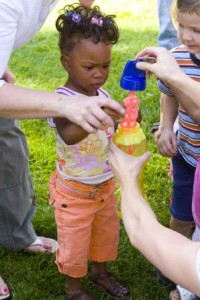 Falling in Love with your Family by Alison
Falling in Love with your Family by Alison
In a Nutshell: Sometimes a problem behavior just needs a change to the environment.
There are lots of different ways to look at human behavior. Some experts think that our behaviors are determined genetically; some think we are products of our environment. It probably isn’t a question that will soon be settled, but they both present interesting ways to look at solving problems. For example, when a there is a consistent problem that keeps surfacing at home, try looking at simply changing the environment instead of always having to change the child.
Some of these small changes might make a big difference. A simple example would be if a crawling baby keeps getting into books on the bottom shelf of a bookcase, change the environment by putting baby toys on the bottom shelf and moving the books to the top of the closet for a year or two. The simple environmental change keeps you from constantly reprimanding your baby, and keeps your books safe as well.
I found that simple things often have a big impact. We had trouble getting a child who hates mornings to drag herself out of bed. We kept playing with the routine until we decided it was better to get breakfast in her first, instead of trying to keep her tired feet moving while getting ready for school. My preschooler has much better mornings when I take a couple of minutes and just snuggle him after he wakes up, instead of plunging him into the daily hustle. These simple environmental changes have made all the difference.
Other problems are more complicated, but maybe the solutions can be found in easy environmental fixes. Simply turning off the TV while you are trying to have a conversation may reduce friction. Letting a teen make a storage room into a reading corner might cut down on sibling rivalry. Eating outside after a bad day may help change the mood from frantic to festive. Blowing bubbles during a tantrum just might turn the tide and return your sweet two-year-old back to your arms.
When you see a problem behavior, instead of always assuming that the child has to change, take a minute to think of ways the environment might be able to change…and maybe the problem will solve itself.
